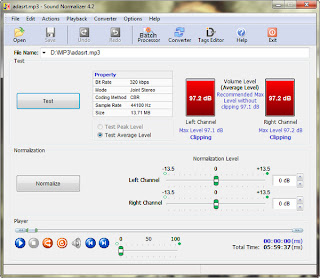
- #Video sound normalizer how to
- #Video sound normalizer full
- #Video sound normalizer software
- #Video sound normalizer professional
Here’s how you can apply this effect to an audio clip. In DaVinci Resolve, you can normalize audio levels using the “Audio Gain” node.
#Video sound normalizer how to
How to Normalize Audio Levels in DaVinci Resolve

It’s important to be careful when normalizing audio levels and to keep an eye on the audio waveform in the timeline to make sure that it doesn’t go into clipping territory. Normalizing audio levels can cause audio to become too loud, resulting in audio clipping.
#Video sound normalizer full
The dBFS (Decibels Full Scale) level is a measurement of the relative loudness of an audio signal compared to the maximum possible level that can be represented by a digital audio system. It’s basically a value that represents the overall loudness of the audio clip, and it is often used in audio engineering to determine the appropriate level of gain to apply to an audio signal to reach the correct amount of “loudness.” In general, a higher RMS level indicates a louder audio clip, while a lower RMS level indicates a quieter audio clip. The RMS (Root Mean Square) level is a measure of the average power of an audio signal over time. It’s important to understand the differences between these options and how they affect the final audio level of your exported video. Note that some NLEs may have more advanced normalization options (we’ll get to that in a minute), such as the ability to set a target RMS level or to normalize to a specific dBFS level.


If there’s an effect for normalization, apply the normalization effect to the audio clip.Set the normalize or gain level to your desired maximum or minimum level.Look for a normalize or gain control option (we’ll go over where to find this).Navigate to the audio mix or audio effects section of your NLE.Select the audio clip you want to normalize.

The steps to normalize audio in NLEs vary depending on the application you’re using, but the general process is as follows: Clipping is when the volume of a clip exceeds a certain threshold and begins to distort.
#Video sound normalizer software
Normalizing audio in Non-Linear Editing (NLE) software is a process of adjusting the volume level of an audio clip so that it reaches a maximum or minimum level without clipping. So let’s talk about what this means and how you can do this with the various applications you might be using. We don’t necessarily even need to be expert sound engineers and mixers to get quality audio from our footage.
#Video sound normalizer professional
However, while these might be elements we can’t necessarily control as editors, one way we can ensure the final product sounds professional is to normalize the audio in our editing programs. The reasons one might end up with bad audio can range from unfavorable equipment to recording conditions to file corruption. One of the most frustrating things that can happen to us as video editors is working with (and ending up) with poor audio.


 0 kommentar(er)
0 kommentar(er)
